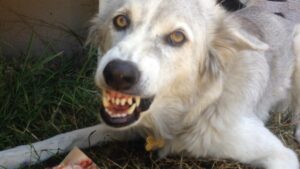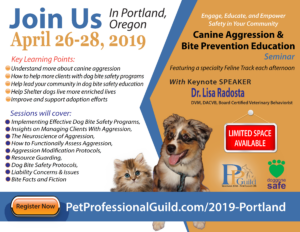Barks Blog
Portland Blog Competition: Aggression by Any Other Name
By Stephanie Peters

“Help, my dog is aggressive!” This is often the first thing that I hear from potential clients when they contact me for a training or behavior consultation. They may be troubled by certain behaviors their dog is demonstrating, and are either panicked that they have somehow caused the behavior, or worried that their dog is inherently “flawed.” Our culture sometimes has a tendency to pathologize aggressive behaviors in our beloved pets—who are, let’s remember, animals—and there is something of a dearth of information available to pet guardians on this topic, so my clients may come to me already fearing the worst. They don’t know, for example, the difference between biting and mouthing, and may be at a loss for what to do when their dog growls.
The truth is that at one time or another dogs may well display a behavior we hurriedly and inappropriately label as aggressive, and that those behaviors may very often be perfectly normal responses to something the dog finds stressful, frightening, painful, or overwhelming. This behavior could be the result of any combination of factors, including genetics, in-utero and early puppy development, previous life experiences, current environmental influences, underlying medical conditions, improper socialization, use of aversive or punishing equipment or techniques, and more. So, join me as I wade into the quagmire that is “canine aggression.”
After reviewing a detailed intake form, discussing their dog in person, and observing their dog in his home, I am usually delighted to inform the vast majority of my clients that their dog is, in fact, not aggressive. The first thing I tell my clients is that, in my opinion, aggression is overly diagnosed, and that what they might consider to be “scary-looking” behaviors that their dog sometimes exhibits do not generally qualify as true offensive or defensive aggression. In order to properly address this multitude of “scary-looking” behaviors that our dogs are capable of expressing, we have to get specific—the language we use matters, and it matters a lot.
For example, rather than generically labeling a behavior as “food aggression,” I use the more accurate term, resource guarding, and we determine the exact triggers that cause the guarding behavior. Does the dog guard a bowl with food in it, an empty bowl, food scattered on the floor, treats fed in a hand, a high value chewable item? Does the dog guard food resources only from other dogs, or from humans, or both? Are there specific locations where the dog is more likely to guard food, or types of food the dog will guard above others?
When a client describes that their dog is “aggressive toward other dogs” while on walks, this usually means the dog is struggling with leash reactivity. My clients are amazed and relieved to learn that their dog is actually afraid of or frustrated by the presence of the trigger, and that Rufus barks at the scary thing to get it to go away, not because he wants to attack the other dog. When left untreated, reactivity can develop into true aggression, so it is imperative that we help the dog learn new emotional associations with their triggers and put management strategies in place, including use of humane walking equipment and a comprehensive muzzle training protocol if needed.
When a client describes that their dog is “aggressive toward people,” this again indicates reactivity, which could be generalized or extremely specific. Are these people children or grown-ups? Are they carrying bags, wearing hats or glasses, or using mobility equipment? Are they near or far, stationary or in motion? Does the dog display the behavior at their own home, or in public, or both? Again, we need to dig deep in order to determine the dynamics of the interaction. More often than not, an undersocialized or fearful dog is put into situations which he cannot escape, such as when “Uncle Joe” who has “owned dogs all his life” assures that Rufus will be “fine” and reaches out to pet the dog regardless of being warned not to. Sometimes dogs with chronic, undetected physical conditions like ear infections or hip pain are unintentionally manhandled by kids, which cause them to snap. Or, the dog is hounded in his own yard (where he is often left unsupervised for long periods of time) by neighbors who senselessly reach across the fence to pet the dog, or even to hit the dog. One of my clients related stories of a former neighbor who caused her dogs to develop barrier reactivity by spraying them with a hose through the chain link fence, yelling at them, and rubbing his body along the fence at them in some misguided expression of “dominance.” Those poor Labradors, what were they to make of this bizarre display? In addition to implementing a program of behavior modification for the dog, I teach my clients how to politely but very firmly advocate for their dog in social situations, and how to prevent problematic incidents in the first place by increasing supervision and keeping their dogs under threshold as much as possible.
What about dogs who are admonished for growling—period? People may view growling dogs as dangerous, rather than realize that a growl is one form of vocalization that dogs use to communicate their internal state. A growl gives us valuable information, and should be respected and duly noted, rather than punished. Owners may mistake a play growl as “aggression” and interrupt appropriate play between two dogs who were just having fun. A well-timed, appropriate human intervention can de-escalate rough play and ensure that play stays safe for all dogs involved, while other attempts to “stop aggression” between dogs can actually cause an inter-dog issue where there, in fact, was none. On the opposite end of the continuum, owners may see aggression as a desirable trait. They may believe that dogs just “work it out” for themselves and that certain dogs are inherently “submissive” while others rightfully assert their “dominance.” Fortunately, we now have the tools and research available to us to be able to accurately interpret dog body language and understand basic behavior science (see Danger! Dominance Theory! Why Every Mention of “Alpha Dogs” or “Dominant Dogs” is Dangerous to All Dogs).
Whenever we talk about aggression, we must keep in mind that aggressive behavior is not an ethical issue for the dogs. Rufus is not twisting his moustache with an evil glint in his eye, thinking up new and horrible ways to terrorize people and other dogs. Some dogs may be socially awkward, while others may be overly exuberant, and some are just plain fearful. Dogs make their choices based on safe vs. unsafe. Rather, it is we bipedal creatures who bring our primate brains to weigh in on the issue of aggression in dogs, and attach moral meanings to canine behavior where there simply is none. My clients sometimes worry that their dog now “hates” them or that their dog was “angry” with their child and that is what precipitated a growl or an air snap or a bite, when in reality the dog is simply responding to something they perceive as a threat to their safety or a disturbance to be rid of.
We often tend to impose our own human value systems on dog behavior when we decide whether an aggressive response from a dog was “justified” or unjustified, “provoked” or unprovoked; if the bite happened as a result of someone petting, hugging, or kissing a dog then we may label it “aggression,” whereas a bite inflicted in the name of protection may be deemed warranted. Many owners actively want their dog to lash out, but only in the name of “protection”—the trouble is that Rufus truly does not necessarily distinguish between intruders and “bad guys” from the delivery person, the next-door neighbor, or grandma. Commonly, the snarling, lunging dog is exhibiting fear or resource guarding, as oppose to true protection. On the subject of moralizing, I must also briefly mention the muddy waters of intrinsic prey drive, which is demonized as “aggression” when the target is a young human or another pet, but merely called “hunting” when the target is a bird, rabbit, or squirrel.
Canine aggression is a complex topic, one fraught with all sorts of misinformation, outdated and harmful approaches to treatment, and dubious human interpretation. However, one thing is clear about aggression in dogs: pet guardians need more resources on the topic, and pet professionals need specialized training to respond to the myriad behaviors that are lumped under the umbrella of “aggression.” A good first step is to get specific and describe these various behaviors with accurate language, because aggression called by any other name may not in fact be aggression!
References
Miller, P. (2018). Danger! Dominance Theory! Why Every Mention of “Alpha Dogs” or “Dominant Dogs” is Dangerous to All Dogs
*This post is the joint winner in our Portland 2019 Writers’ Competition. All winning and runner up entries will be published in the March 2019 issue of BARKS from the Guild. To learn more about canine and feline aggression, join us at the Pet Professional Guild Canine Aggression and Bite Prevention Educational Seminar (with bonus feline specialty track) in Portland, Oregon April 26-28, 2019.*
About the Author
Stephanie Peters is a KPA-CTP and CPDT-KA certified trainer and an ACDBC certified behavior consultant, who provides private, in-home pet training with specializations in behavior modification, adopted dogs, and family-friendly services via her practice, Plucky Paws in Ames, Iowa. As a certified humane education specialist with 15 years teaching experience, she uses the arts to teach children about important topics like responsible pet ownership, dog bite prevention, and companion animal welfare. She is passionate about companion animal welfare, and volunteers with adoptable dogs at the Animal Rescue League of Iowa and the PAWS program at the Iowa Correctional Institution for Women. She maintains strong ties to Best Friends Animal Sanctuary, where she completed an internship in Dogtown, is a member of several prominent professional organizations, and is involved in ongoing education.

